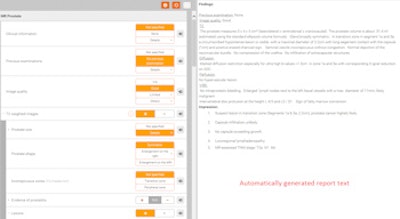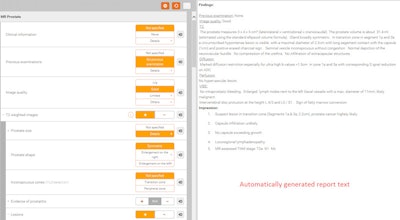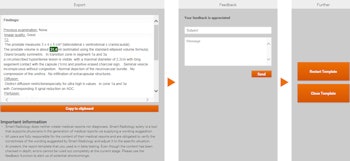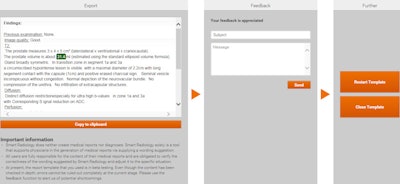
Structured reports of shoulder MRI studies tend to be more comprehensive and relevant than traditional free-text reports, and surgeons appreciate those benefits for expeditious clinical decision-making and surgical planning, German researchers have reported.
In a Ludwig Maximilian University of Munich study comparing structured reports and free-text reports for shoulder MRI, surgeons found the structured reports to have higher quality and were more complete and easier to get the information they need.
"Structured reporting potentially facilitates clinical decision-making and surgical planning in musculoskeletal imaging and potentially leads to a higher satisfaction of referring physicians," Dr. Marco Armbruster said. He shared the group's experience during a session at the recent RSNA 2015 meeting in Chicago.
Value of structured reporting
Numerous studies in the literature recently have reported on the benefits of structured reporting in radiology, particularly in oncologic applications such as staging pancreatic or rectal cancer. Researchers have also cited advantages such as improved completeness and relevance of the reports, as well as enhanced communication with clinicians. However, not much is known about the value of structured reports in musculoskeletal imaging, Armbruster said.
As a result, the group set out to compare structured reports and traditional free-text reports in MRI of the shoulder and to evaluate the quality of these reports on the satisfaction of referring physicians and any potential effects on surgical planning. In a retrospective, single-center study, the team included 30 patients who received shoulder MRI for trauma, luxation, or a possible tendon tear. The patients had a mean age of 45 (± 18 years) and included 21 men and nine women.
Using the PHP programming language, the Sympony 2 Web application framework, and a relational standard query language database, the group developed an online structured reporting platform. The online platform, called Smart Radiology, is compatible with the Integrating the Healthcare Enterprise (IHE) management of radiology report templates (MRRT) standard.
"Furthermore, it works with Radlex playbook IDs," he said. "It is possible to create, manage, as well as import and export radiologic templates."
The structured reporting templates developed for shoulder MRI studies included checklists for important anatomical structures and relevant pathologic changes, predefined text for every decision element, and decision support functionality for many of the report elements, Armbruster said.
The templates are available on the platform's website.


While radiologists work off the structured report checklist on the left side of the Web page, the report text is automatically generated on the right side. All images courtesy of Dr. Marco Armbruster.
For the study, structured reports were generated retrospectively by a second-year resident using the software. A radiologic consultant confirmed the resident's findings. Both the resident and consultant were blinded to the original free-text reports and clinical data. The free-text reports had been produced during the clinical routine by radiologic consultants with many years of abdominal imaging experience.
Surgeon preferences
Next, two surgeons evaluated both the free-text and standardized reports, assessing each for: the inclusion of predefined key features, value for clinical decision-making, sufficiency for surgical planning, and the convenience of information extraction. They also rated the reports on both linguistic and overall quality, Armbruster said.
| Surgeon evaluation of reports | ||
| Free-text reports | Structured reports | |
| Able to make clinical decision without further consultation | 22/30 (73%) | 26/30 (87%) |
| Sufficient for surgical planning | 18/30 (60%) | 26/30 (87%) |
| Missing key features/considered to be incomplete | 14/30 (47%) | 5/30 (17%) |
In other findings, the surgeons considered it easy to extract information from 25 (83%) of the structured reports, compared with only 14 (46%) of the free-text reports. Some effort was required to extract information from five (17%) of the structured reports, compared with 14 (46%) of the free-text reports. Two (8%) of the free-text reports were considered to be time-consuming to extract information from, compared with none of the structured reports.
The surgeons also gave higher overall quality scores to the structured reports, a difference that was statistically significant (p = 0.001). However, differences in linguistic quality ratings did not reach statistical significance (p = 0.175).


After the report is finished, it can be imported to most RIS/PACS software by either copying and pasting the report, or by using the "copy to clipboard" button.
The researchers acknowledged a number of limitations of their study, including its retrospective design and small sample size. The lack of linguistic differences between the reports may be due to missing statistical power from the small sample size, they noted.
There is also the potential for an observer bias due to the approach of comparing structured reports with free-text reports produced in the clinical setting, according to the team.
University spin-off
The Smart Radiology platform is now managed by QMedify, a University of Munich spin-off. Four German structured reporting templates are now available on the site (MRI/CT staging of hepatocellular cancer; MRI staging of prostate cancer; MRI staging of rectal cancer; MRI of the shoulder; and CT of the heart). The English version of Smart Radiology is expected to be released in March, Armbruster said.


















